SINGLAUB—
Parachuting Into Prison
Special Ops in China
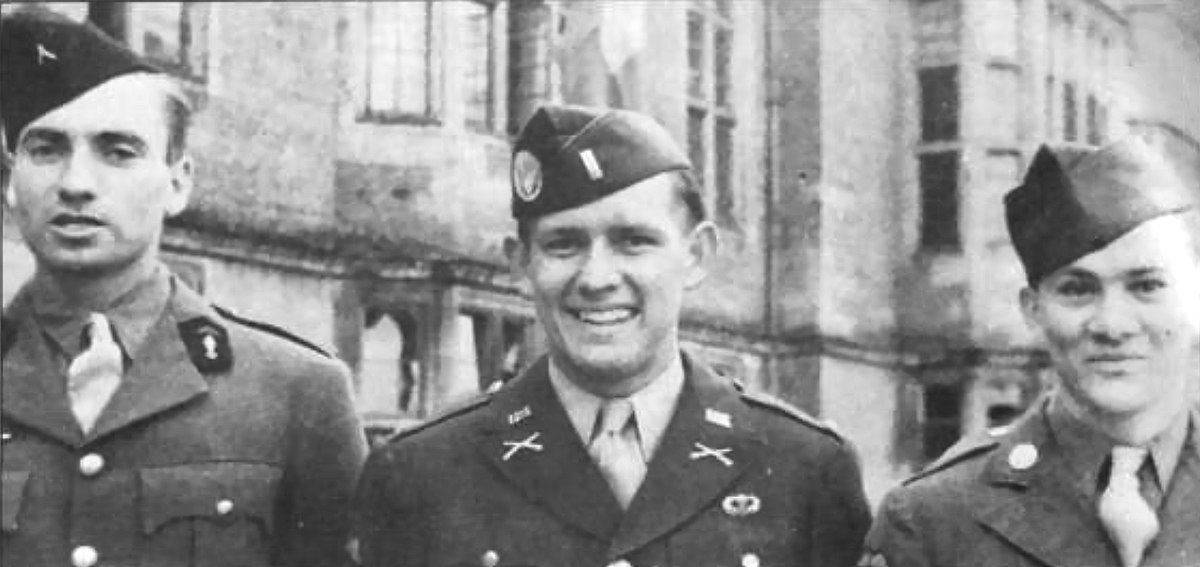
Singlaub, center, and his Jedburgh team prior to secretly parachuting into occupied France to organize resistance against the Germans.
By Jim Morris
Originally published in the September 2020 Sentinel
Editor’s Note: World War II had jolted America into a frenzied mobilization by the time ROTC Cadet Jack Singlaub graduated from UCLA in 1942. Just over a year later, having displayed exceptional leadership skills with small teams in Commando ROTC exercises at Fort Benning, Georgia, he was offered the chance to volunteer for unspecified “hazardous duty behind enemy lines.” Singlaub accepted and found himself joining the Office of Strategic Services (OSS). He was assigned to a Jedburgh team, a three-man commando unit that heavily influenced evolution of the present-day Special Forces A-Team concept.
Singlaub’s Jedburgh team ultimately parachuted well behind German lines into southern France, to help the local resistance prepare for the soon-to-come D-Day invasion of Normandy. The adventures of young 1st Lieutenant Singlaub and his battalion-sized force of maquis irregulars were chronicled by Jim Morris in the August 2020 issue of the Sentinel. (see “SINGLAUB: The Jedburgh Mission” page 2.)
Following the successful completion of his mission in France, he volunteered in December 1944 for reassignment in Asia. He departed soon thereafter for training on Catalina Island, and from there deployed to the China-Burma-India Theatre.
The little town of Bhamo sits astride the headwaters of the Irawaddy River, which runs southward out of the mountains along Burma’s Chinese border to parallel the famed Burma Road through Mandalay and on to the jungled delta around Rangoon.
United States Army Captain Jack Singlaub got there the hard way, arriving with his OSS company in Calcutta after transiting the Pacific from southern California by ship. From the Indian port they moved onto the upper Assam Valley, in what is now Bangladesh. After being assigned to OSS Detachment 101, a command and control unit commanded by Colonel Ray Peers, they moved on to Bhamo.
Colonel Peers, later to become commanding general of the 4th Division in Vietnam and chairman of the Peers Commission to investigate the My Lai massacre, told Singlaub that he would have to hold for a few weeks on his permanent orders to join another OSS detachment over the mountains in Kunming, China. Not one to sit on his hands until his mission priority allowed him and his assortment of commando troops to fly over the hump into China, Singlaub heard that his CO, Col. Peers, planned to move some of his assets from a place called Dinjan, in the upper Assam Valley, to Bhamo in Burma.
“I volunteered to run a series of convoys up the Burma Road with this equipment, to occupy my guys while we were waiting to get over the hump.” Singlaub recalled. “So we took that on, and drove the Ledo Road up to Bhamo in Burma.”
But typically, just when Singlaub thought his unit would have to hang around and wait, they were told to get up and go.
“Then, strangely enough, we flew back from Bhamo to Chabua and then flew on over the hump to Kunming,” Singlaub said. “I had been put in charge of a combined company in California… It was made up of a lot of OSS types. So I had Army, Navy and Air Corps officers. And I had Army, Navy and Marine Corps enlisted. And I had male and female civilians. Processing these people was really something, because each service had its own peculiarities.
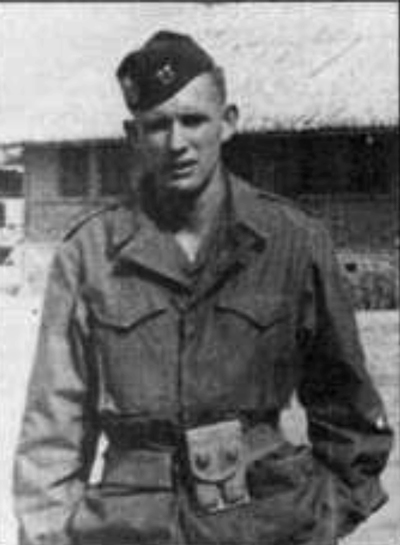
Singlaub in the OSS compound in Kunming, China
Kunming
“When we got to Kunming, I did some Chinese language training, and then went down to Poseh and trained some Chinese guerrillas for operations against the Japanese,” he said.
Chinese guerrillas weren’t the only troops being trained by the OSS in Indochina. This brought Singlaub into contact with Viet Minh forces under the command of an insurgent leader named Ho Chi Minh.
“By this time I had my team, and we had a weapons man, a medic and my radio operator, and an executive officer. We had about five, all Americans. We were to take a team into what later became North Vietnam. My mission,” Singlaub recalled, “was to blow the railroad and a road between Hanoi and the town of Langson.
“The road and the railroad were on opposite sides of this gorge. It was a very deep gorge and the railroad was an easy one to cut because it had a lot of curved rails and a limited number of culverts.
“The road was more difficult,” Singlaub said, “but again it was very steep in several places and it had culverts. I was able to spot the culverts and compute my charges. And I found out where my drop zone was going to be. We were to take in some Vietnamese with us when we went.
“When I went on flights in a C-47 to make a reconnaissance of my targets, as well as my drop zone and so on, I carried along supplies to drop to the [OSS] team that was advising Ho Chi Minh. So I would fly over Ho Chi Minh’s headquarters at a place called Tuyen Guang. Mike Holland was one of the guys who was in with Ho Chi Minh, and a Major Thomas. I didn’t know the others.”
Twenty years later Ho’s troops would be fighting and killing U.S. servicemen, but he was more of an unknown quantity at the time, and certainly still conducive to providing at least limited support to U.S. and European interests. Singlaub remembers the Ho Chi Minh of Japanese occupation days as a man who “had a lot of ability to get people to work with him. He continued to promise that they were going to attack the Japanese. They didn’t do as much attacking of the Japanese as we would have liked. But at that time the Vietnamese that I worked with — and they had run intelligence nets — said that they recognized the need for continuing help from the West, and they expected the French to return.
“They wanted to be able to teach Vietnamese in their schools,” Singlaub said, “and they wanted some concessions from their colonial rulers. But they did not want to give up contact with the West. They said they would prefer that the Americans would come in and take over that role, but recognized that that was not likely.
“But they did not have that absolute hatred and intransigent position that they later took. That’s a long story, and a very complicated and involved story: how that developed.”
Change in Orders
As it turned out, though, Singlaub’s mission to blow the road and the rail line was never carried out. There was a temporary postponement in July because of conflicting mission priorities, and then it was permanently scrubbed by an event that surprised everyone.
“We were in this little jungle town and some people came in and said that a big bomb had been dropped on Japan, and the war was going to be over.” recalled Singlaub, who at the time expressed disbelief. “We didn’t know what they were talking about. Then eventually we were told that our mission was canceled and they were sending a plane to pick me up. A day or so later a plane came in and flew us hack to Kunming. And then they said that the States had dropped an atom bomb on Japan.”
Everyone figured a Japanese surrender was at hand. But many problems remained, chief among them the thousands of U.S. prisoners in Japanese camps and the fear that they might not live long enough to see repatriation, especially if the Japanese decided to take out their frustrations of defeat on the POWs. And if the Japanese already had mistreated the prisoners, it would be to the advantage of the vanquished to simply execute the POWs and hide the bodies. It was decided that the OSS should undertake operations aimed at freeing the POWs as soon as possible.
New Mission
“They asked if I would lead a team to go into Hainan Island, where they thought they had some prisoners,” Singlaub said. “There were other teams being brought back from other parts of China, where they had been fighting against the Japanese. Teams were to be sent to Hainan Island, Taiwan, Mukden, Peking, Shantung, Shanghai and Korea.
“I elected to jump my force because we didn’t have an airfield. Besides, with the team that went to Taiwan, the Japanese just put a pistol to their faces and said to get back on the airplane,” he said.
“I recruited my team— took some of my same team members and added to them. We parachuted into this area where we assumed the camp was. In the two days I was given to get ready for this, that was an important part of it — to analyze photos and try to see where the camp was. I finally was convinced of the exact buildings, from the air photos, and I selected a drop zone. We flew from Kunming one night, over the Gulf of Tonkin, right on the deck, just 50 feet off the ocean, made landfall — I recognized it from the studies — turned right, flew along the coast until I could see the camp and my selected drop zone.
“So we went in and I picked out my heading and told the pilot to let us out at 600 feet.
“We parachuted into this area, which was within sight of the buildings we thought were where the POWs were. The aircraft was supposed to make another pass and drop our equipment but … I don’t know if he was trying to get lower and look and see if we were all right, but he dropped the supplies at an altitude that was too low for the parachutes to open.
“So my radio was about two meters wide by 50 meters long. The bundle just exploded and ruined a lot of the other supplies we were taking in there as well. So we were without a radio.”
That wasn’t the worst of it. By early August 1945, many of the Japanese had seen the writing on the wall and were talking of surrender. But unfortunately for Singlaub, the 10,000 Japanese on Hainan Island — big, strapping Hokkaido Marines who had been winning all their battles down in the Pacific — had not heard that the war was about to end.
On Hainan Island
“They weren’t very kind to us for the first 36 hours,” Singlaub said “They policed us up and put us in a guardhouse. But I wouldn’t talk to the captain that was commanding the camp. I said I wanted to talk to his colonel.
“We heard him on this telephone because he had to yell loud. I had a Nisei and a Chinese with me as interpreters, as part of the nine-man force. The Japanese captain said, ‘But Colonel, he won’t talk to me. He insists on talking to you. The major insists on talking to you.’ I was actually a captain, but for that jump the intelligence people convinced my team and me that I should wear major’s leaves. So I was a brevet major.
“And it was a good thing, because there is such a big distinction between company and field grade officers in the Japanese Army. As a major I wouldn’t deign to speak to this captain.
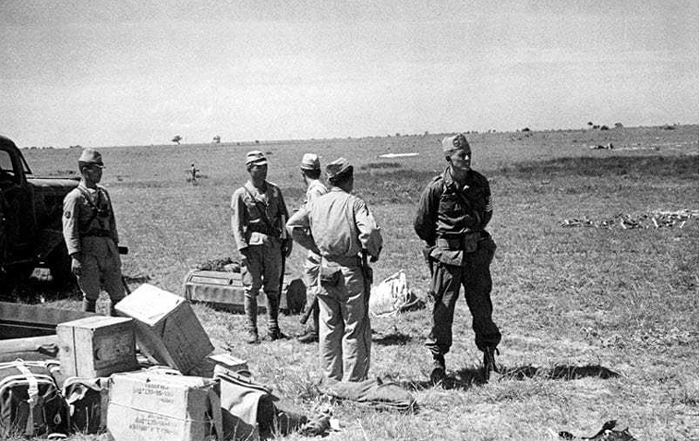
Major Singlaub (right) turning his back on a Japanese lieutenant with whom he refused to negotiate, demanding to see the colonel in charge of 10,000 Japanese marines holding Hainan Island.
“ ‘But Colonel, he insists that Japan is going to surrender!’ ‘But Colonel, they jumped in broad daylight!’ We could only hear one end of the conversation, but we could tell roughly what it was.
“So I had a very, very nervous night, without any communications; in fact, locked up in the guardhouse. I had insisted that I wanted to see the commander of the Allied prisoners, and that I wanted to see the colonel who was commanding this area.
“The next day they finally took us over where I met with the Japanese commander. I told him that I absolutely insisted on seeing the Allied officers in the camp. He apparently had gotten the word by this time that the Japanese were about to surrender. So I told him that I was commandeering all the food on the island, and that, after Allied needs were met, he would have the next priority. All the transportation I was commandeering, all the communications. And I wanted a liaison officer assigned to me immediately, but that the first order of business was to talk to the prisoners.
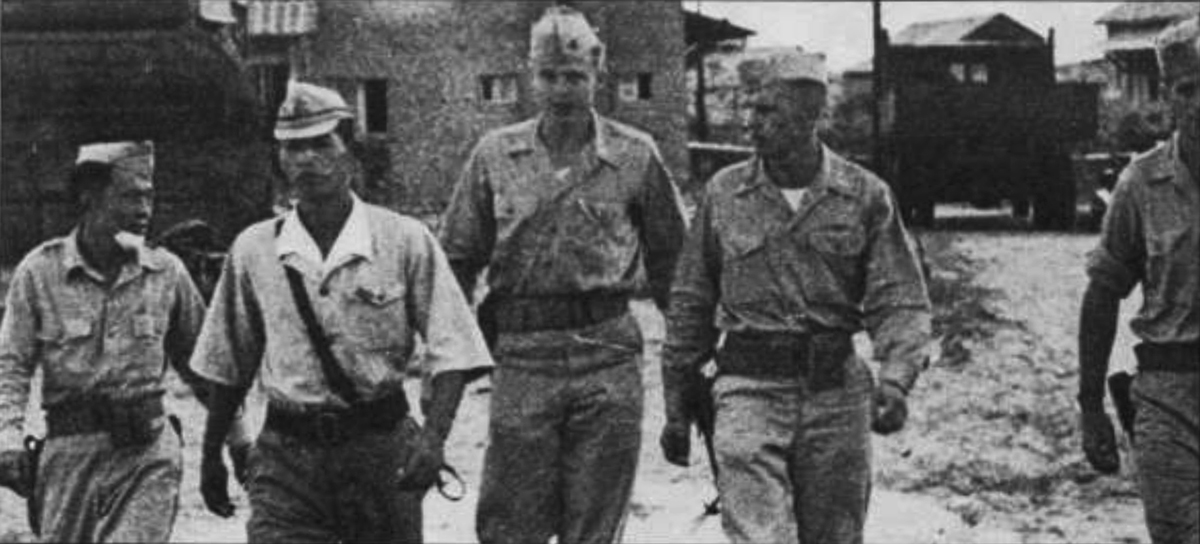
Brevet Major John Singlaub, fourth from left, tours Japanese prison compound with OSS rescue team on their second day on Hainan Island, just east of the Gulf of Tonkin.
Meeting the Australians
“So they were brought to an Australian colonel, the senior officer, and a Dutch lieutenant commander.” Singlaub recalled. “It was quite a reunion. Very emotional, as you can imagine.
“I moved the Japanese to the side, set these guys down, after shaking their hands, and found out what their real problems were. They went back to their quarters. So then I issued some ultimatums to the Japanese, as to what was going to be done specifically.
“That operation, I suppose, was one of the most satisfying that you could have. Not only providing freedom to almost 400 prisoners of war, but we had the job of bringing them up-to-date on what had happened since they had been captured. They were captured by the Japanese very early in the Pacific war — in February of 1942 —on a small island in what is now Indonesia, which at that time was the Netherlands East Indies. They had been very badly treated by the Japanese. They had been physically abused. They had been put on this island of Hainan in the most inhospitable part of the island, and when the monsoons hit, the water would not only come through the roof, but through the walls.
“Several were dying each day by the time I got there. So we were able to give them not only freedom, but by feeding them about six meals a day, six small meals a day, we stopped the deaths by starvation, And we gave them vitamin B-1 injections and provided them with some essential medical care; although some still died after we got there.
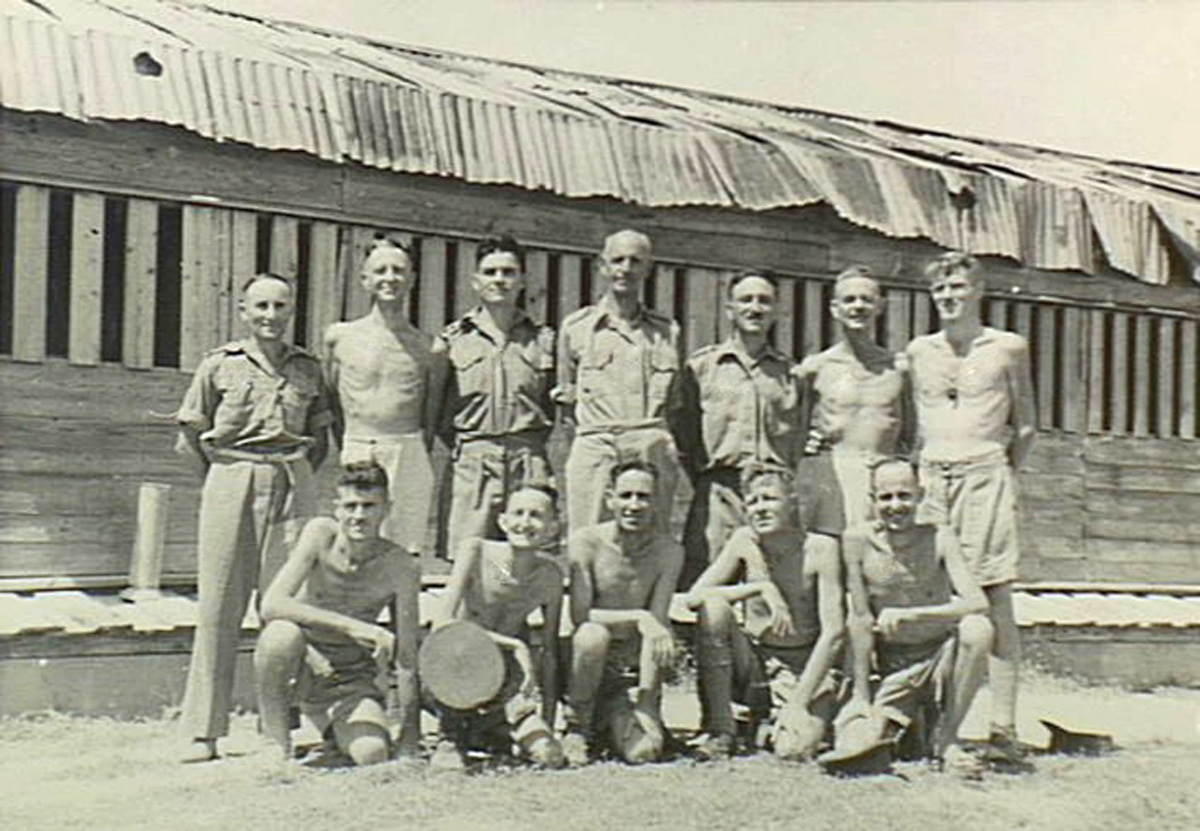
A group of Australian officers poses after their release from a Japanese POW camp on Hainan Island. They were rescued by an OSS team headed by John Singlaub.
Evacuating the POWs
“But then I had the problem of moving them from that location on the west side of the island down to the southern tip, where there was an adequate harbor and an airfield.
“I commandeered a train and was moving them down there when our train was ambushed and the engine was derailed. The rail was blown, but we were flying a home-made American flag on the train. The blue field was denim and the stripes were sheets with the wrong number of stars and the wrong number of stripes.
“But that train was never assaulted. That’s a good thing, because I only had four armed Americans on it. The rest were unarmed prisoners. We never did find out whether that ambush was the work of bandits or guerrillas.
“So we had to go through all of that to get ‘em down there. But eventually we moved them, either by rail or by boat. Some of them weren’t up to rail travel, so we had to move them by boat down to the other end of the island, where I proceeded to set up better hospital facilities.
“It was a better part of the island. There was fresh fruit available for them there. We took over some barracks that had belonged to the Japanese Air Force and made it into a hospital and barracks for the troops, until I could eventually bring in some Australian ships to evacuate the Australians and the Dutch up to Hong Kong.
Locating Escapees
“I found that there were some prisoners who had escaped and were presumed to be with the guerrillas in the interior of the island. Intelligence nets that I set up initially indicated that there had been some Americans who had been captured and killed by the Japanese.
“We produced evidence of this. One of the things that was given to me on my first entry into the camp was a packet of documentation of the atrocities committed against these people, and that evidence, which I personally held on to until I got out and personally turned it over to the British authorities in Hong Kong. It was used as the basic documentation to try some of the Japanese for war crimes after the war.
“I had the problem of locating where these escapees and evaders were… Well, first of all I had the problem of not having any radio. It wasn’t until I got down to the southern end of the island and took over a big Japanese transmitter and sent back a message to Kunming, telling what had happened and where I was, that we made contact.
“Although we had had some signals that we were able to display on the drop zone, it was agreed that 24 hours after our drop, they would send a reconnaissance flight over the drop zone and photograph it. I had a series of signals to display by spreading out the reserve parachutes, which were white, in different patterns.
“Fortunately I was able to get my people — two guys — out of that guardhouse where we were and out to the drop zone to display that signal on the second day. On the first day the recce flight went over and there was nothing. They were quite worried in Kunming.
“Second day I was able to indicate that we were out of communication, but we were okay. We had a way of mutilating the panels slightly, if needed, to indicate we were under duress. The parachutes were displayed correctly, so they knew we were okay.
“When we boomed in with that big signal from the Japanese transmitter, they wouldn’t believe it was us, so we had to go through a lot of challenges to prove that we were, in fact, who we said we were.
Providing Aid
“But I was able then to bring in a doctor on a plane, and I was able to then use that plane to fly over the island. I was able to throw in small bottles of Atabrine (anti-malarial) tablets. I was able to use small parachutes from our jump, the pilot chutes, to float these things down. I would throw them into large villages, with a note that said. ‘Take this to your leader. The Allies have landed a small force on the southern part of the island. The Japanese are in the process of surrendering. The war is over. We want to make contact with any Allied former prisoners or evaders. Any Allied personnel, send a message to the southern part of the island, town of Sanya.’
Two days later we got a message that came in answer to that, signed by an Australian major, indicating that he had a certain number of Australian and Dutch troops with him, plus a large number of Indians who had escaped also. These were members of the Hong Kong and Singapore Royal Artillery. They were Sikhs.
“The Japanese had tried to use them as troops; the Japanese had tried to form a Free India movement. But these people, when given an opportunity to serve, had headed for the hills. There were also some Americans.
“Several messages came in. One of them was signed by the Australian major, and another was from an American who was an evader and who was in the interior of the island with some friendly guerrillas.
“So I had the problem of getting in there as part of my problem of getting all Allied personnel out. I also had the problem of recontacting my exec. The only way I could get to my rear detachment was to parachute in.
Free Fall
“That’s when I made my first free fall. I used one of the emergency parachutes off one of the airplanes that flew in supplies. And I took the reserve that was still intact and cut the old harness that I had jumped in with, tied knots in the risers above the connectors, so that I had a harness for my reserve, and then did a free fall out of a C-47.
“I had no idea how much altitude I should allow, but decided I would need five seconds to clear the airplane and pull the thing, so…”
“Add about 500 feet.”
“Yeah, I computed this on the basis of the velocity of a free, falling body, and jumped from less than a thousand feet. When I got into free falling later on, I realized how silly that was. But anyway it was successful, and I got back in.
“Eventually we had to go back into the interior. That was an exciting thing because the Japanese controlled the perimeter of the island, in most cases. But in the interior there were three separate groups; you had pro-communist guerrillas and pro-nationalist guerrillas, and then you had just plain bandits. I still don’t know who it was that ambushed our train. It may have been just bandits, but in any case we had to go through several territories.
“The Japanese would only take us so far, and then they said, ‘Well, down that road there’ — they called them all bandits — ‘there are some bandits,’ and we’d go down and cautiously display an American flag. They then would take us to the end of the area they controlled, and eventually we got in. We made arrangements to come out a few days later.
“So we brought out several truckloads of escapers and evaders.
“I must say, the Chinese Nationalist commander on the island gave us one of the finest Chinese meals I’ve ever had, in celebration of this great occasion. It was a 26-course dinner, as I recall.
“We evacuated the majority of the prisoners via destroyers. Later, when I reached Hong Kong, I was able to arrange for a hospital ship to come in and pick up the ones who were really in bad shape.
Japanese Surrender
“I had great pressure from the Japanese. They wanted to surrender to me. They did not want to wait and surrender to the Chinese. But it was very clear in my instructions that I would not accept their surrender, and the Japanese just could not understand.
“They wanted to come and present their swords to me, rather than face surrender to the Chinese, whom they had not treated particularly well.
“By that time a group of logisticians from the China headquarters came in and relieved me. They were from the Services of Supply. They had the responsibility of staying there until the Chinese Army came.
“I then embarked the team on an Australian destroyer and sailed to Hong Kong. We happened to be there the night of the official surrender signing. By this time the majority of the ships of the British Navy has assembled in Hong Kong and they put on quite a fireworks display that night.
“That was about the second of September, I think, in ‘45.
“A few days later we flew back to Kunming and I released the team.”
About the Author:
Jim Morris joined 1st SFGA in 1962 for a 30-month tour, which included two TDY trips to Vietnam. After a two year break, he went back on active duty for a PCS tour with 5th SFG (A), six months as the B Co S-5, and then was conscripted to serve as the Group’s Public Information Officer (PIO). While with B-52 Project Delta on an operation in the Ashau Valley, he suffered a serious wound while trying to pull a Delta trooper to safety, which resulted in being medically retired.
As a civilian war correspondent he covered various wars in Latin America, the Mideast, and again in Southeast Asia, eventually settling down to writing and editing, primarily but not exclusively about military affairs.
He is the author of many books, including the classic memoir War Story, now available in Ebook format in The Guerrilla Trilogy, which also includes his books War Story, Fighting Men and The Devil’s Secret Name. The Dreaming Circus was released in the summer of 2022 — information available at https://www.innertraditions.com/books/the-dreaming-circus.
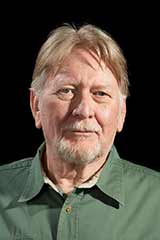
It is wonderful that you write about outstanding people like Jack Singlaub. I met him a few times at SOAR or SFA. Your background is quite impressive. Appreciate what you do. Thank you. Retired in Thailand